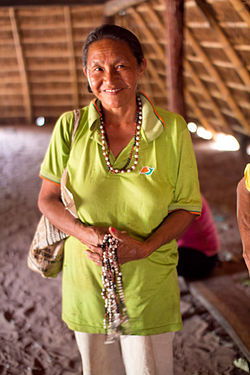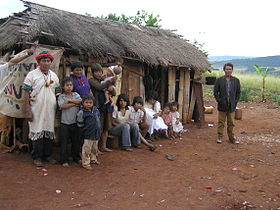Name
The Pai Tavytera are also known as the Ava, Caaguá, Caingua, Caiwá, Kaa'wa, Kainguá, Kaiowá, Kaiwá, Kayova, Montese, Paï, Paï-Cayuä, Paï-Tavyterä, Paingua, Pan, and Tavytera people. "Paï-Tavytera" is an arbitrary name given to northern Guaraní people of eastern Paraguay. [2] They are closely related to the Guarani-Kaiowá people of Brazil.

Guarani are a group of culturally-related indigenous peoples of South America. They are distinguished from the related Tupi by their use of the Guarani language. The traditional range of the Guarani people is in present-day Paraguay between the Paraná River and lower Paraguay River, the Misiones Province of Argentina, southern Brazil once as far east as Rio de Janeiro, and parts of Uruguay and Bolivia.

Rondônia is one of the 26 states of Brazil, located in the northern subdivision of the country. To the west is a short border with the state of Acre, to the north is the state of Amazonas, in the east is Mato Grosso, and in the south and southwest is Bolivia. Rondônia has a population of 1,815,000 as of 2021. It is the fifth least populated state. Its capital and largest city is Porto Velho. The state was named after Cândido Rondon, who explored the north of the country during the 1910s. The state, which is home to 0.8% of the Brazilian population, is responsible for 0.6% of the Brazilian GDP.
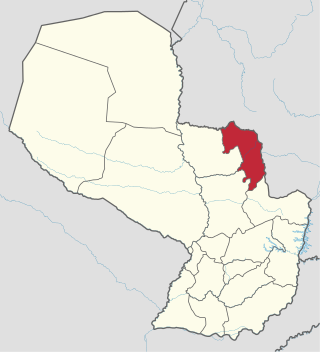
Amambay is a department in Paraguay. The capital is Pedro Juan Caballero.

The Kamayurá are an indigenous tribe in the Amazonian Basin of Brazil. Their name is also spelled Kamayura and Kamaiurá; it means "a raised platform to keep meat, pots and pans." The Kamayurá language belongs to the Tupi–Guarani family.
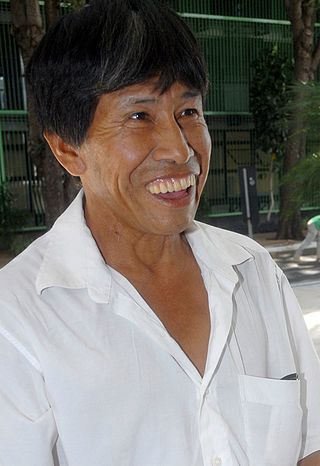
Guarani-Kaiowás are an indigenous people of Paraguay, the Brazilian state of Mato Grosso do Sul and northeastern Argentina. In Brazil, they inhabit Ñande Ru Marangatu, an area of tropical rainforest. This was declared a reservation in October 2004. Marcos Verón, a leader of this people was beaten to death in January 2003.

Guaycuru or Guaykuru is a generic term for several ethnic groups indigenous to the Gran Chaco region of South America, speaking related Guaicuruan languages. In the 16th century, the time of first contact with Spanish explorers and colonists, the Guaycuru people lived in the present-day countries of Argentina, Paraguay, Bolivia, and Brazil.

The Zo'é people are a native tribe in the State of Pará, Municipality of Óbidos, on the Cuminapanema River, Brazil. They are a Tupi–Guarani people.
The Akuntsu are an indigenous people of Rondônia, Brazil. Their land is part of the Rio Omerê Indigenous Territory, a small indigenous territory which is also inhabited by a group of Kanoê. The Akuntsu were victims of a massacre perpetrated by Brazilian cattle ranchers in the 1980s and currently number just three individuals. It is unlikely that the Akuntsu language or culture will survive after their deaths, leading several observers to describe them as victims of genocide.
Chiripá Guarani, also known as Ava Guarani and Nhandéva (Ñandeva), is a Guaraní language spoken in Paraguay, Brazil, and also Argentina. Nhandéva is closely connected to Mbyá Guaraní, as intermarriage between speakers of the two languages is common. Speakers of Nhandéva and Mbyá generally live in mountainous areas of the Atlantic Forest, from eastern Paraguay through Misiones Province of Argentina to the southern Brazilian states of Paraná, Santa Catarina, and Rio Grande do Sul. There are approximately 4,900 speakers in Brazil and 7,000 in Paraguay.
Mbya Guarani is a Tupi–Guarani language spoken by approximately 6,000 Brazilians, 3,000 Argentines, and 8,000 Paraguayans. It is 75% lexically similar to Paraguayan Guarani.
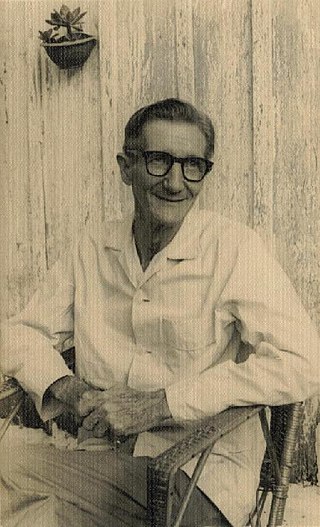
León Cadogan was a Paraguayan ethnologist who made significant contributions to the study of Guaraní language and culture.
The Júma are an indigenous people of Brazil, who lived in the Terra Indígena Juma in the Amazonas, along the Mucuim River, a tributary of Rio Açuã.
Pãi Tavyterã is a Guarani language spoken by about 600 Pai Tavytera people in eastern Paraguay, in Amambay, eastern Concepción, eastern San Pedro, and northern Canindeyú Departments. The language has 70% lexical similarity with the Kaiwá language, spoken in Brazil. Among Pai Tavyetera people, language use is shifting towards Guaraní.

Paraguayan Indigenous art is the visual art created by the indigenous peoples of Paraguay. While indigenous artists embrace contemporary Western art media, their arts also include pre-Columbian art forms. Indigenous art includes ceramics, baskets, weaving and threading, feather art and leather work. It is a hybrid nature includes the embroideries, lace, woodcarving and different metal products. Paraguay is particularly known for its indigenous featherwork and basket weaving.

The Kadiwéu are an indigenous people of Brazil. In 1998, they lived in four villages, with some families living independently in the jungle. They are known for their horse riding skills.
The Uru-Eu-Wau-Wau are an indigenous people of Brazil, living in the state of Rondônia.
The Anambé are an indigenous people of Brazil, living in the state of Pará, Brazil.
The Tembé, also Timbé and Tenetehara, are an indigenous people of Brazil, living along the Maranhão and Gurupi Rivers, in the state of Amazonas and Pará. Their lands have been encroached and settled by farmers and loggers, who do so illegally, and the Tembé are working to expel the intruders from their territories.
The Suruí are an indigenous people of Brazil who live in the state of Pará. They are a different people than the Suruí do Jiparaná.
